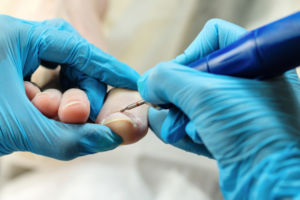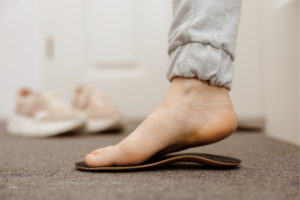
What is Involved in Nail Surgery?
A common concern we hear is that Nail surgery is scary and extremely painful. I’m here to tell you that this is not the case! Keep reading to find out more..
Introduction
An ankle syndesmosis injury is a common cause of pain at the front (anterior) of your ankle. This injury is also referred to as a high ankle sprain as it affects the ligaments above the ankle joint. Whilst an ankle syndesmosis injury is less common than your traditional ankle sprain, the associated symptoms are often more disabling and the recovery period longer.
Relevant Anatomy
Your lower leg consists of two bones, the tibia and the fibula. The distal tibiofibular ligament holds these two bones together just above the ankle joint. In addition to this, there is a fibrous connective tissue that assists in holding the tibia and fibula together. This fibrous tissue is known as the syndesmosis.
The role of the syndesmosis is to provide stability and support during rotational movements and loading of the ankle joint. During weightbearing activities there will be a small amount of widening between the tibia and fibula. The syndesmosis prevents these two bones from widening too far.


What Causes A Syndesmosis Injury?
Ankle syndesmosis injuries often occur when the foot is planted on the ground and the leg is twisted inwards (internally rotated), or if the foot itself is forcefully twisted outwards (externally rotated). This mechanism of injury results in an over-stretching and, potentially, tearing of the distal tibiofibular ligament and syndesmosis. This type of injury is more common in the sporting population, especially sports such as football and snow skiing.
Symptoms Of Syndesmosis Injuries
These are the most common, but not limited to symptoms that most patients experience with a syndesmosis injury:
As there are varying degrees of syndesmosis injuries, the severity of the symptoms will vary based on the amount of damage done to the ligament(s). Ligamentous injuries have the following classifications:
Grade | Features |
1 | · Over-stretching of the ligament with no tearing of fibres. · Recovery can be expected to be approximately 6 weeks. · Return to high level sporting activity however may take longer due to the physical demands.
|
2 | · Partial tearing of the ligament and can be further classified as unstable or stable. · Recovery is between 6-12 weeks · If the ankle is classified as unstable, surgery may be required.
|
3 | · Complete rupture of the ligament. · This type of injury will require surgery and recovery time will be between 3-6 months.
|
Diagnosis of Syndesmosis Injuries
Your podiatrist will first take you through a thorough history and clinical examination. During the clinical examination your podiatrist will assess the integrity of the distal tibiofibular ligament and syndesmosis, as well as the range of motion and strength of your ankle. Palpation and functional testing are also included in the clinical examination.
Further imaging
If a syndesmosis injury is suspected you may be referred for further investigations such as weight-bearing X-rays, ultrasound, CT scan or MRI. These scans will help to confirm/rule out any diagnoses and also determine whether an associated fracture is present.
Treatment of Syndesmosis Injuries
Treatment is based on the severity of the injury. Regardless of the severity, the following goals need to be met for adequate healing and to prevent recurrence:
There are a number of specific conservative treatment options available to assist in the treatment of these injuries. These include:
Surgery
Surgical intervention is only required for unstable syndesmosis injuries (high grade 2 and grade 3). Pins are inserted to hold the tibia and fibula together to prevent widening during weight bearing activities, which restores the stability of the ankle. Surgery is usually considered last and will need to be consulted with by a specialist. A referral to a specialist can be organised through your doctor.
In Conclusion
A syndesmosis injury is serious and can lead to severe complications if left untreated so its important to see someone if you are worried that this has happened to you. Feel free to come into our clinic and have a chat to us at any time! One of our experienced podiatrists will take you through a comprehensive assessment and discuss your treatment options with you, so you can get back to your activities as soon as possible.
Thanks for reading and have a great day!
The team at Sole-Lution Podiatry

A common concern we hear is that Nail surgery is scary and extremely painful. I’m here to tell you that this is not the case! Keep reading to find out more..

Heel pain is one of the most common complaints that we hear in the clinic. Regardless of what it is caused by…

Ask any podiatrist and they will tell you how often they get asked by their patients “Do I need custom orthotics”? The answer is not as simple as most people think…

Corns and warts are both skin conditions that can develop on various parts of the body, particularly on the hands and feet.